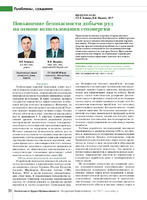Increase in safety of ores extraction on the basis of geoenergy use
Abstract
Classification of research methods of the stressed-deformed state of rocks by the development and introduction of synergy group of methods including entropy, thermodynamic and energy approaches is improved. Processes of energy exchange in the rock massif and regular transformations of one types of energy to other are studied. Mine and laboratory pilot studies, mathematical and physical modeling, and also theoretical analysis and generalization of the obtained results using standard methods are performed. On 36 development workings and 25 shrink stoping located in the interval of depths from –507 to –1008 m the ellipsoidal form of areas of deformation of the massif, and also the power dependences of increase of the part of influence of the entropy to 95 % of the total energy balance of external stresses on the example of rocks of Krivoy Rog iron ore basin are established. Check of the simulation results of zonal capsulation of the underground workings massif on the laboratory models, which showed reliability of more than 89 %, is performed. Analysis of the areas of massif zonal deformation revealed by the field studies showed reliability of the obtained data of not less than 84 %. Power dependences of change of the sizes of the adjacent energy zones, which ratio is the constant from the overall dimensions, depth of laying and physical properties of the massif containing the working are established. It is proved that the share of energy of the rock pressure directed to maintenance of mine workings or exposed surfaces of the operational units is described by parabolo-hyperbolic law. It allows to achieve saving of resources to 37 % due to use to 86 % of energy rock pressure by decrease of geodynamic activity of the massif using rock anchor, which neutralizes convergence of massif due to energy divergence.

